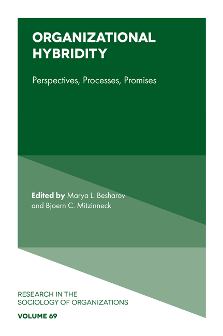
Index
Organizational Hybridity: Perspectives, Processes, Promises
ISBN: 978-1-83909-355-5, eISBN: 978-1-83909-354-8
ISSN: 0733-558X
Publication date: 7 December 2020
Citation
(2020), "Index", Besharov, M.L. and Mitzinneck, B.C. (Ed.) Organizational Hybridity: Perspectives, Processes, Promises (Research in the Sociology of Organizations, Vol. 69), Emerald Publishing Limited, Leeds, pp. 313-320. https://doi.org/10.1108/S0733-558X20200000069014
Publisher
:Emerald Publishing Limited
Copyright © 2021 Emerald Publishing Limited
INDEX
Note: Page numbers followed by “n” indicate notes.
- Prelims
- Chapter 1: Heterogeneity in Organizational Hybridity: A Configurational, Situated, and Dynamic Approach
- Section A: Multiple Theoretical Lenses
- Chapter 2: Hybridity and Institutional Logics
- Chapter 3: Taking Hybridity for Granted: Institutionalization and Hybrid Identification
- Chapter 4: Reasoning with Heuristics: A New Approach to Categories Theory and the Evaluation of Hybrids
- Chapter 5: A Paradoxical Approach to Hybridity: Integrating Dynamic Equilibrium and Disequilibrium Perspectives
- Section B: Varied Empirical Contexts
- Chapter 6: Business Sustainability as a Context for Studying Hybridity
- Chapter 7: How the Zebra Got its Stripes: Individual Founder Imprinting and Hybrid Social Ventures
- Chapter 8: New Hybrid Forms and Their Liability of Novelty
- Chapter 9: Let’s Talk about Problems: Advancing Research on Hybrid Organizing, Social Enterprises, and Institutional Context
- Section C: Multilevel and Dynamic Approaches
- Chapter 10: Shift in Hybridity in Response to Environmental Complexity: The Transformation of the Italian Guardia di Finanza
- Chapter 11: Hybrid Agency: Sheltered Workshops (1941–2019)
- Chapter 12: Institutional Settlements and Organizational Hybridity: The Rise and Fall of Supervised Consumption Sites
- Chapter 13: Legitimacy Trade-Offs in Hybrid Fields: An Illustration Through Microfinance, Impact Investing and Social Entrepreneurship
- Index